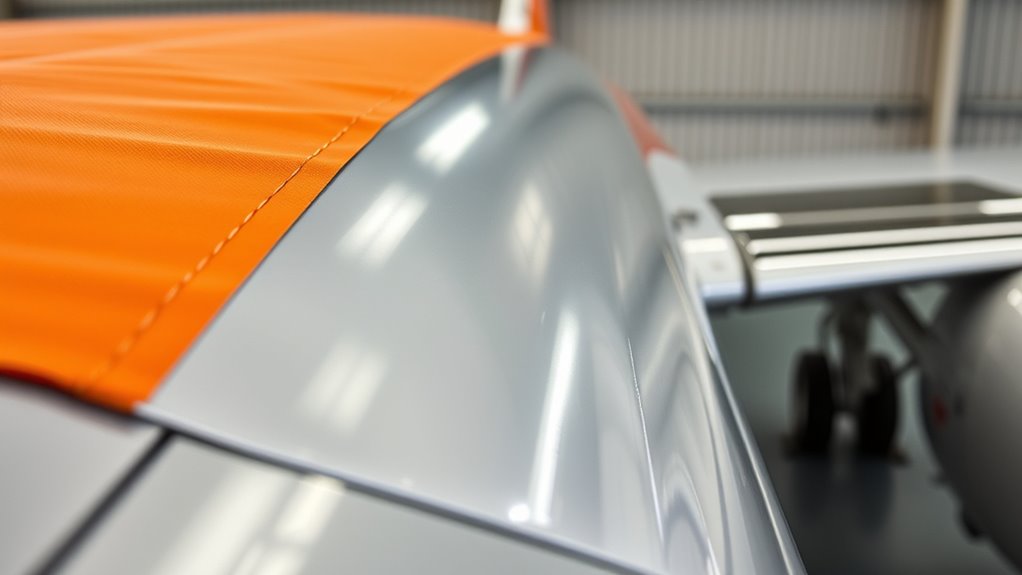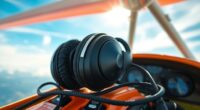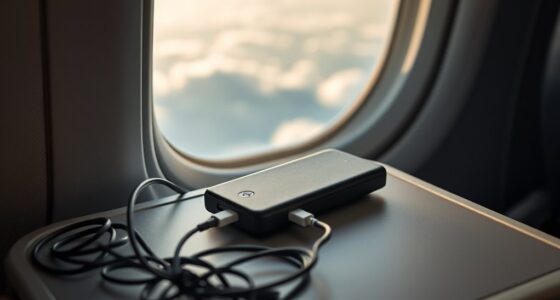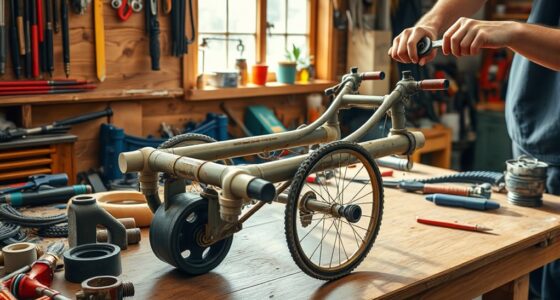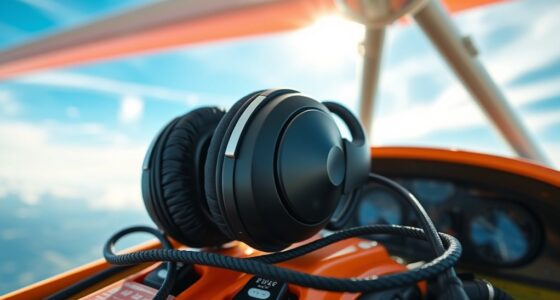To prevent hangar rash, you should opt for high-quality, custom-fit wing covers made from durable, impact-resistant materials. Look for covers that fully protect your aircraft’s surfaces, feature reinforced seams, and are easy to install and remove. Proper handling, regular inspections, and choosing breathable, UV-resistant fabrics will maximize protection and longevity. Keep exploring to discover more tips on selecting and maintaining the best protective covers for your aircraft.
Key Takeaways
- Choose full-coverage, custom-fit wing covers made from durable, impact-resistant materials to prevent scratches and dents.
- Ensure covers have reinforced seams and edges for added strength and tear resistance during handling and storage.
- Opt for high-quality, weather-resistant fabrics that offer UV protection and prevent moisture buildup to reduce corrosion risk.
- Properly install covers with a snug fit, avoiding excessive tension, and handle with care during installation and removal.
- Regularly inspect, clean, and maintain covers to identify damage early and extend their protective lifespan.
Understanding Hangar Rash and Its Causes
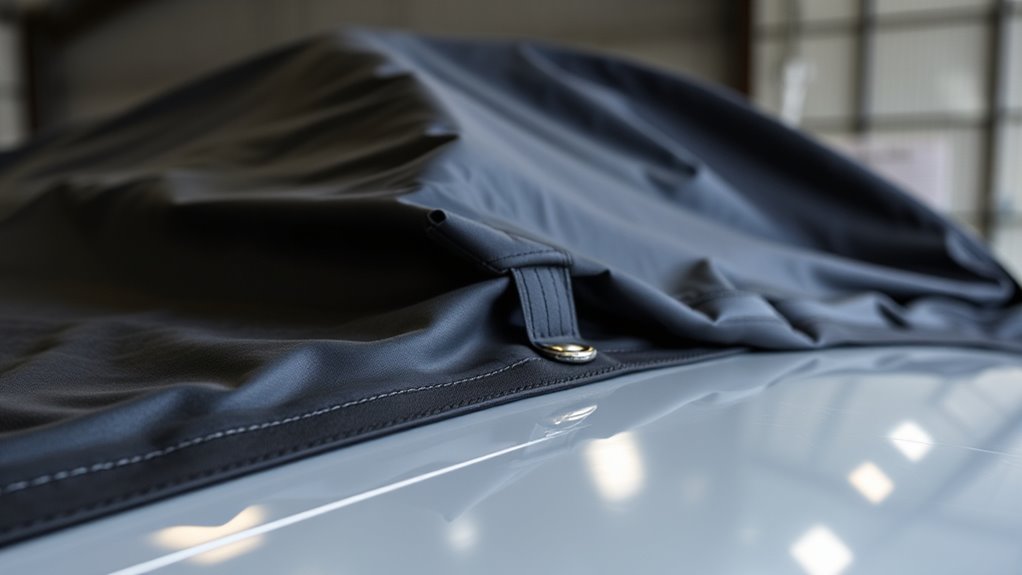
Hangar rash occurs when your aircraft’s wing covers sustain scratches, dents, or paint damage while stored in a hangar. This damage often results from contact with tools, equipment, or other aircraft, which can chip or scratch the aircraft’s paint. The condition of your aircraft’s paint plays a vital role in its overall appearance and resale value. Poor cover durability can lead to increased risk, as flimsy covers may shift or tear easily, exposing the aircraft to potential harm. Ensuring your covers are durable minimizes the chance of accidental damage during storage. Regular inspections and choosing high-quality, resilient covers help protect the aircraft’s paint and maintain its pristine condition, reducing the likelihood of hangar rash and prolonging the life of both the paint and the wing covers. Additionally, selecting high-quality materials for your covers can significantly enhance their resistance to wear and tear.
Features to Look for in Protective Wing Covers

What features should you prioritize when selecting protective wing covers to guarantee maximum durability and protection? First, look for a wing cover design that offers full coverage without gaps, ensuring your wings are protected from accidental contact. A custom fit is essential, so choose covers tailored to your aircraft’s specific dimensions to prevent slipping or exposing vulnerable areas. Durability matters too—opt for covers made from tough, resilient materials that withstand hangar conditions. Easy installation and removal are also key, saving you time and effort during routine handling. Finally, check for reinforced edges or seams to prevent tearing and extend the cover’s lifespan. Incorporating inspirational quotes about fatherhood can remind you of the importance of caring for your aircraft with the same love and dedication as you would for loved ones. Prioritizing these features ensures your wing covers effectively prevent hangar rash and keep your aircraft in top shape.
Materials and Construction of Effective Covers
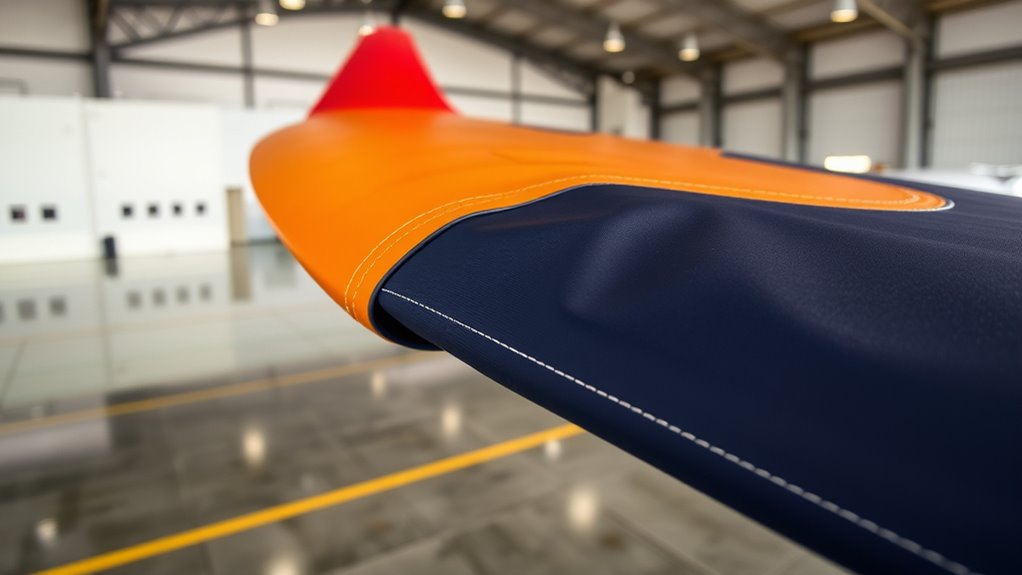
Choosing the right materials and construction methods is key to making effective wing covers. You want durable fabrics that withstand weather and wear, along with seamless techniques that prevent leaks and tears. By focusing on these points, you can guarantee your covers provide reliable protection. Incorporating high-quality fabrics ensures longevity and resistance to environmental elements.
Durable Material Choices
Selecting the right materials for protective wing covers is crucial to guarantee durability and effective protection. You want materials that withstand impact and resist wear over time. Reinforced fabric is an excellent choice because it offers strength without adding bulk. Impact resistant materials, such as high-density plastics or rubber coatings, help absorb shocks and prevent damage. Look for covers with layered construction that combine these elements for maximum durability. Quality materials ensure your covers can handle routine handling and accidental bumps in the hangar. Choosing the right durable materials extends the lifespan of your covers and keeps your wings protected against hangar rash. Investing in high-quality options saves you money and effort in the long run. Durable material choices like impact-resistant composites can provide enhanced protection against accidental impacts. Keep these factors in mind for long-lasting, effective protection.
Seamless Construction Techniques
Seamless construction techniques are essential for creating protective wing covers that offer maximum durability and a clean, professional appearance. You achieve this through seamless stitching, which eliminates weak points and reduces the risk of tears. Edge reinforcement further enhances durability by strengthening vulnerable areas, preventing fraying and wear over time. When designing your covers, focus on continuous, tight stitches that maintain integrity across the entire surface. Proper edge reinforcement ensures the cover withstands repeated handling and exposure to elements. Incorporating specialized materials can further improve the overall strength and longevity of the covers. This combination results in a cover that fits snugly, resists damage, and looks polished. Below is a table highlighting the key benefits of seamless construction techniques:
| Technique | Benefit |
|---|---|
| Seamless stitching | Eliminates weak points |
| Edge reinforcement | Extends cover lifespan |
| Tight stitching | Prevents tearing |
| Continuous seams | Maintains structural integrity |
| Durable materials | Supports seamless construction |
Benefits of Using Protective Wing Covers
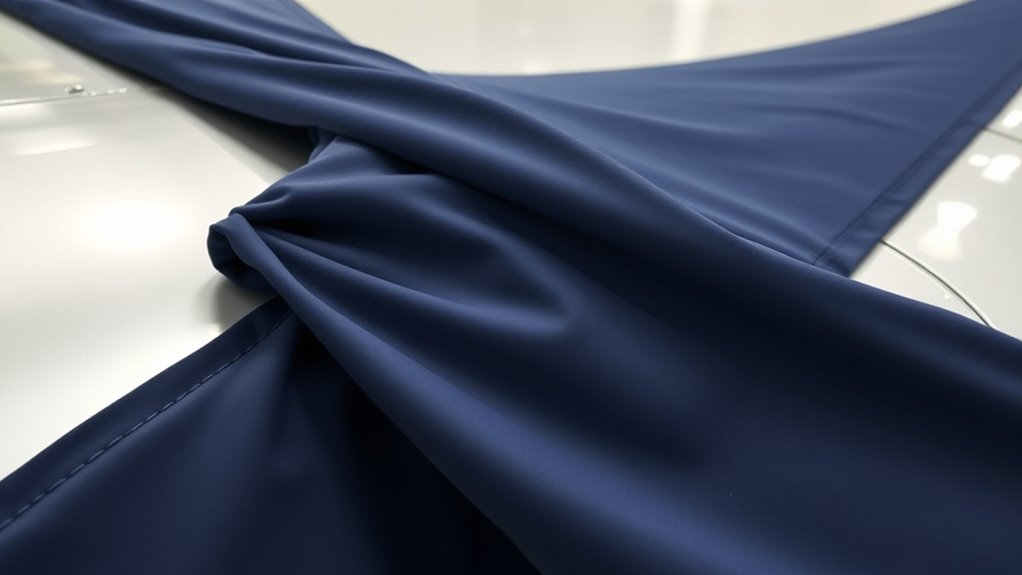
Using protective wing covers keeps your aircraft surfaces in top condition, preventing damage from environmental elements. This simple step also helps cut down on maintenance costs over time. By investing in covers, you protect your aircraft’s value and reduce unexpected repairs. Vetted wing covers ensure quality and safety for your aircraft.
Protects Aircraft Surfaces
Protective wing covers serve as a crucial barrier that shields aircraft surfaces from damage caused by environmental elements. They prevent scratches, corrosion, and dirt buildup that can compromise the aircraft’s integrity. By safeguarding the wings, you reduce the risk of costly repairs and maintain ideal performance. These covers also help preserve the aircraft interior by reducing debris entry and minimizing maintenance disruptions. During pilot training, using protective covers ensures the aircraft remains in top condition, reducing downtime. Additionally, they make handling aircraft easier and safer, especially during storage or pre-flight checks. Overall, protective wing covers are essential for maintaining aircraft surface integrity, ensuring safety, and extending the lifespan of your aircraft’s wings and related components. Proper use of paint sprayers can also ensure surface protection during maintenance processes.
Reduces Maintenance Costs
Have you ever considered how protective wing covers can substantially cut your maintenance costs? By shielding your aircraft’s surface, they help preserve the aircraft paint and prevent corrosion, reducing the need for frequent repairs. This minimizes downtime and repair expenses, saving you money over time. Using wing covers means less scrubbing, repainting, and corrosion treatment, which can be costly. To understand this better:
| Cost Savings Area | Description | Impact |
|---|---|---|
| Paint Maintenance | Protects aircraft paint from damage | Less repainting needed |
| Corrosion Prevention | Shields against corrosion buildup | Reduced repair costs |
| Downtime Reduction | Keeps aircraft ready for use | Increased operational efficiency |
How to Properly Install and Maintain Wing Covers
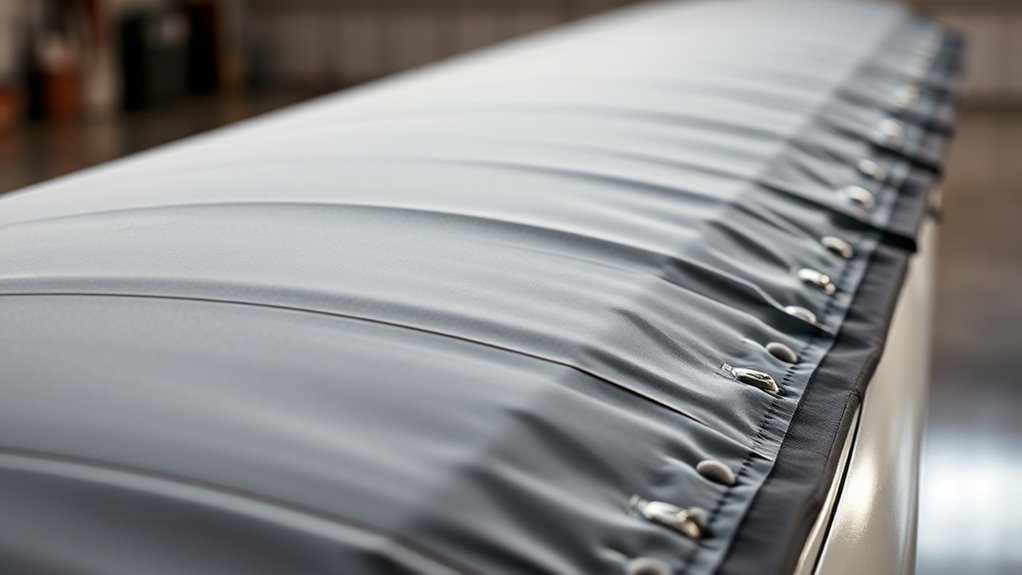
Proper installation and maintenance of wing covers are essential to guarantee your aircraft’s wings stay protected from the elements and damage. Start by ensuring the covers fit snugly without excessive tension, which can cause tears or wear. Use appropriate storage solutions when the covers aren’t in use to prevent deformation or dirt accumulation. Follow consistent cleaning protocols to remove dust, dirt, and debris that could degrade the material over time. Regularly inspect the covers for tears, holes, or loose fasteners, and repair them promptly. Keep the covers clean and dry, and store them in a cool, dry place away from direct sunlight. Proper care maximizes the lifespan of your wing covers and maintains their protective qualities. Understanding industry trends helps in selecting the right covers and techniques for optimal protection.
Comparing Different Types of Wing Cover Options
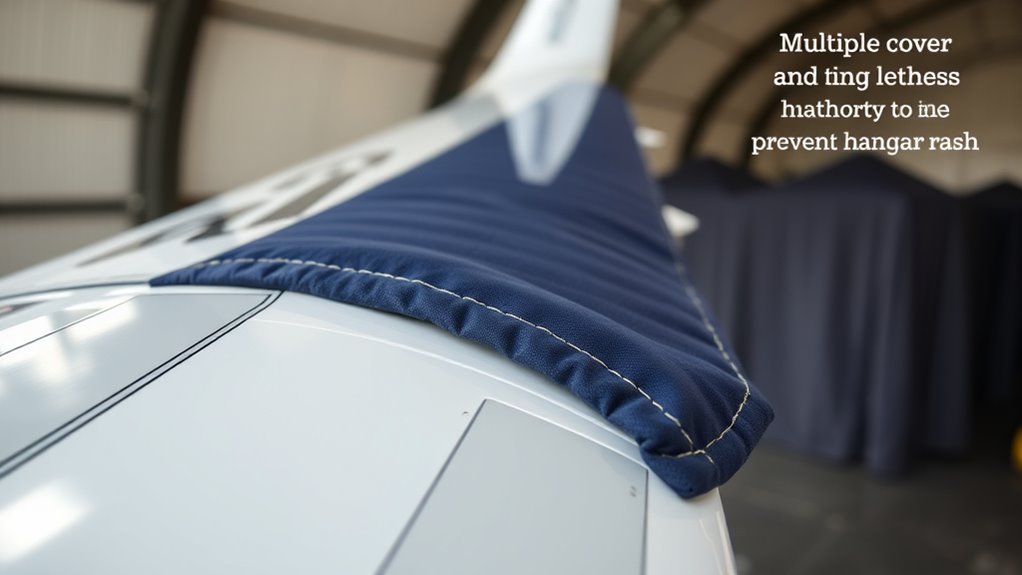
Choosing the right wing cover depends on your specific needs and the conditions your aircraft faces. Different options vary in fabric breathability, durability, and color choices. Breathable fabrics prevent moisture buildup, reducing corrosion risk, while non-breathable covers offer better protection against dust and debris. Color options also matter; lighter colors reflect sunlight, keeping your wings cooler, whereas darker shades provide better UV resistance. Vetted – Halloween Product Reviews Here’s a quick comparison:
| Feature | Cover Type A | Cover Type B |
|---|---|---|
| Fabric Breathability | High | Low |
| Durability | Moderate | High |
| Color Options | Wide (white, gray, blue) | Limited (mostly dark shades) |
Assess your climate and storage needs to select the best option.
Tips for Selecting the Best Cover for Your Aircraft
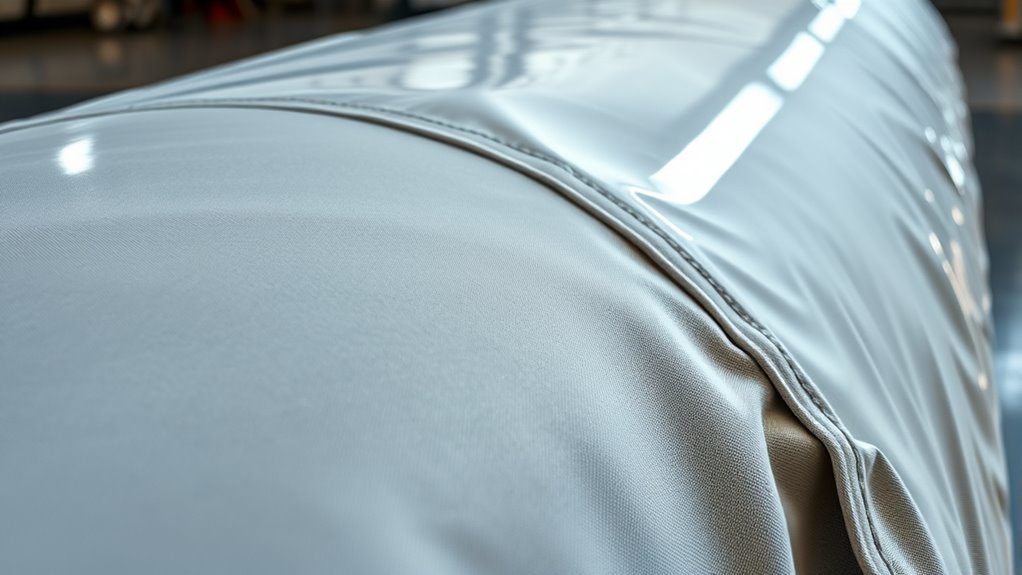
When selecting the best cover for your aircraft, consider how your specific use and environment will impact its longevity and performance. Think about factors like exposure to UV rays, moisture, and debris, which can affect your aircraft paint and overall condition. A high-quality cover should fit well, be durable, and allow for proper cover storage when not in use. Also, check if it’s breathable to prevent moisture buildup that can damage paint or promote corrosion. For hangar storage, choose a cover that’s easy to handle and clean. Remember, the right cover protects your aircraft’s finish and extends its lifespan, saving you money in the long run. Focus on materials that resist weather, UV, and wear for the best protection. Additionally, selecting a cover with adequate breathability helps prevent condensation buildup that can lead to corrosion or paint deterioration.
Frequently Asked Questions
Are Protective Wing Covers Suitable for All Aircraft Sizes?
When considering protective wing covers, you wonder if they’re suitable for all aircraft sizes. You should check wing cover compatibility carefully, as not all covers fit every aircraft. Larger aircraft need more robust, specifically designed covers, while smaller planes may require less extensive options. Always consider aircraft size considerations to guarantee a proper fit, preventing damage and ensuring the covers do their job effectively, regardless of your aircraft’s size.
How Do Wing Covers Impact Aircraft Weight and Fuel Efficiency?
You might worry about how wing covers affect your aircraft’s weight impact and fuel efficiency. Generally, they add some weight, but it’s minimal and doesn’t considerably impact fuel efficiency. The main benefit is protecting your wings from damage, which helps maintain ideal performance. So, while wing covers do add a bit of weight, they’re a small trade-off for preserving your aircraft’s condition and ensuring it operates efficiently over time.
Can Wing Covers Be Used During Flight or Only on the Ground?
You might wonder if wing cover installation is suitable during flight or only on the ground. Typically, wing covers are designed for ground use, ensuring protection from hangar rash and debris. Using them during flight isn’t recommended, as it can compromise flight safety considerations. Always remove wing covers before takeoff to maintain peak aircraft performance and safety, and only install them during ground operations for protection.
What Is the Typical Lifespan of a Protective Wing Cover?
You might wonder about the typical lifespan of a protective wing cover. Generally, it depends on material durability and manufacturing processes. High-quality covers made from durable materials can last several years, especially if properly maintained. Regular inspections help identify wear and tear early. Using covers suited for your aircraft and following manufacturer guidelines guarantees they stay effective longer, protecting your wings from hangar rash and extending their lifespan.
Are There Any Maintenance Costs Associated With Different Cover Materials?
Think of cover material durability as your airplane’s armor—some last longer, while others need frequent replacements. You’ll find that more durable materials often have higher upfront costs but reduce long-term maintenance expenses. Cheaper covers may save money initially but might wear out quickly, increasing replacement frequency and costs. So, consider the balance between initial investment and longevity to keep your wing cover maintenance costs in check.
Conclusion
To prevent hangar rash, you need the right protection, proper installation, and regular maintenance. Choosing quality wing covers ensures you guard your aircraft from scratches, dings, and damage. Properly installing your covers guarantees an effective barrier, while consistent upkeep prolongs their lifespan. Protect your investment, preserve your aircraft’s condition, and enjoy peace of mind. Remember, the best protection combines quality, correct use, and ongoing care—because safeguarding your aircraft is worth every effort.
With a heart that soars as high as the skies, Aria, affectionately known as “Skylark,” is the driving force behind Soaring Skyways. Her journey into the gliding world began as a young dreamer gazing up at the soaring birds, yearning to experience the weightlessness and freedom they embodied. With years of experience both in the cockpit and behind the scenes, Aria’s commitment to the gliding community is unwavering.
